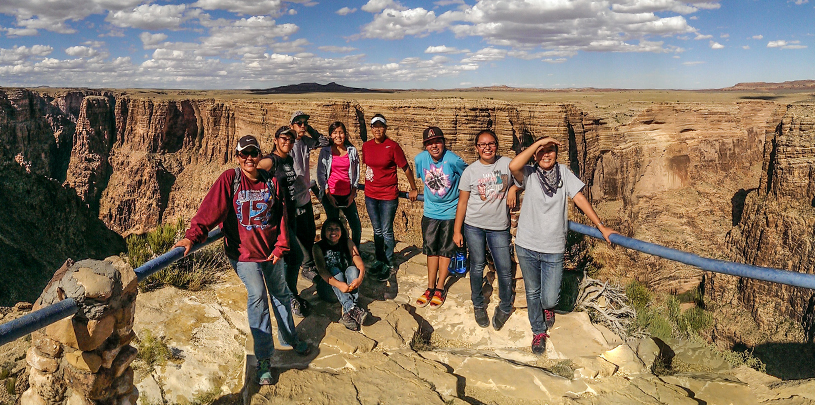
 by Sarana Riggs, Native America Volunteer Coordinator, Americorps
by Sarana Riggs, Native America Volunteer Coordinator, Americorps
On a beautiful, sunny morning in the Painted Desert, we could see scattered homes and corrals of the Diné People on the distant horizon of Cameron, Arizona. While power lines ran overhead, it was clear that many of the homes and families in the area had no electricity, no way to tap into the grid pulsing high voltage energy above.
For the group of students accompanying me on this whirlwind tour and introduction to Navajo Nation issues, culture, and history, the Moenkopi substation would prove to be the perfect first stop.
Electricity from the four powerhouses of the Southwest—Glen Canyon Dam, Navajo Generating Station, San Juan Generating Station, and the Four Corners Power Plant—converges at the substation in Cameron, from where the massive pool of electrons is routed to every corner of the Southwest. The Kinlani Dorm students, many of whom come from Western Navajo and neighboring tribes but attend high school in Flagstaff, were surprised to learn that the resources originating from within the reservation fuel and power the growth of distant cities like Phoenix, Las Vegas, and Los Angeles. Not surprising, their questions turned to the lack of electricity in their rural communities along with the lack of running water in their homes back on the reservations.

(Moenkopi Substation)
But at the next stop, Cameron Chapter President Milton Tso offered an optimistic perspective of economic development on the reservation. Infrastructure improvements are coming, he said, pointing to the newly built highway and sidewalks in the small town of Cameron as examples. He told the students that sidewalks give an impression of a real city, not the usual low-income reservation vibe of the Navajo Nation.
Another issue, which Tso described to the students, stems from the hundreds of abandoned uranium mines scattered throughout the reservation. These mines, remnants of the Cold War era, have contaminated precious water sources in an already arid environment and brought cancers and other illnesses to native people.
While the high school students were in no position to tackle the problem of radioactive contamination on the Navajo Nation, it turns out they could do a small part to improve the health of the land at our next stop.
For the service-learning component of our trip, we traveled to the small hogan that houses the Navajo Nation Park Office, located next to the newly built road in Cameron. There we met Robert, the maintenance man, who resides in Black Mesa but travels over 90 miles daily to ensure that the Little Colorado River Navajo Tribal Park is clean, maintained, and safe for visitors. In the spirit of Robert’s dedicated land stewardship, we set out to beautify the lands by collecting trash and maintaining the rough trail that leads visitors to the Little Colorado River Gorge.
While picking up empty bottles and wrappers, we came upon old refuse piles from a historic homestead. Among the desert vegetation, extracting the debris proved tricky. The students noticed the lack of recycling receptacles at the overlook, despite many trash bins located nearby. After our community service, we all admired the breathtaking view of the gorge, the distant blush of the Vermilion Cliffs, the cool and inviting forest near Grey Mountain, and the far-off terrain of the Kaibab Plateau.
Since many of the students had never been to the Grand Canyon, we decided to visit Desert View Watchtower. Here, the students and staff of Kinlani Dorm were taken aback by the beauty of the canyon. We discussed our tribal spiritual connections to the Grand Canyon, from a place of emergence to a home in which we return when we leave our physical bodies. We talked about how our ancient ancestors lived, farmed, hunted, and conducted ceremonies above and below the rim of the Grand Canyon. We shared clan origin stories and prayers of the Navajo tribe, which originated from our deities, including Changing Woman and Salt Woman. Tribes and clans aside, when we got together for a group picture, we felt a spiritual connection between us all.
The last part of our journey was dinner provided by Marie Goldtooth and her elderly mother in the juniper and ponderosa pine below Grey Mountain. It is here where many of the Kinlani students felt at home and were excited to help prepare dinner and take walks near the family hogan.
Our hosts prepared familiar foods, including tortillas and Navajo tea, the highlight of the meal. The family told of stories of relocation, water scarcity, problems with their wind turbine, and the preparations required for winter in this harsh environment. Each one of us could relate to their stories in our own families and homes.
Soon, the disappearing sun and the newly emerging stars signaled the end of the day. We thanked and hugged our hosts, leaving with bellies full of traditional food, minds full of culture and history, and hearts full of possibility.
Comments (1)
Leave A Comment